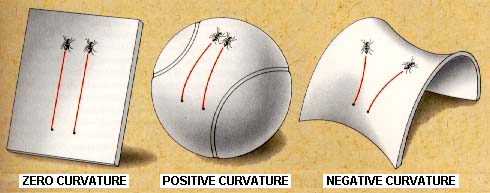
Example: Cartesian planar coordinates (x1,y1) & (x2,y2). The metric defining the distance between these points is simply given by
What is the metric defining the distance between two events? Here's one in Euclidian geometry, from special relativity:
This metric has the advantage of being
invariant
under a Lorentz transformation -- that is, observers in different
inertial
frames will all measure the same interval ds.
Note that, unlike spatial intervals, the spacetime interval ds2 can be positive, negative, or zero. What does this mean?
But who says the spatial geometry is Euclidian? It seems to be on small scales, but what about on the largest scales? Remember what general relativity says: spacetime can be curved.
Take another two dimensional example: the surface of a sphere. If points on a sphere of radius R are marked by coordinates theta and phi, the spatial distance between them is given by

This metric is different than
the one for
euclidian
geometry -- the distance between two events depends on the curvature of
spacetime.
Keep thinking about two dimensional surfaces.

Unfortunately, it is much harder to
visualize the
extension
of this analogy into curved three dimensional
space. Nonetheless it is an extremely useful analogy which
we
will often return to.
Question: How does the volume of space differ at large distances for
different spacetime curvatures? How could we test this?
We need a metric that reflects this -- it must be invariant under translations (homogeneous) and under rotations (isotropic). Only three possibilities exist, and they are all contained in the most general form of the spacetime metric (derived in 1934): the Robertson-Walker metric.

What is all this?
Comoving coordinates are coordinates that move along with the overall expansion of the universe.Imagine a distant galaxy. It is located at the coordinate (r,theta,phi). As long as no force acts on it, it will always be at that coordinate.
Its true distance does change, and is given by R(t) times the comoving distance (=Rr in a flat universe). But the change in the true distance is completely described by the change in the expansion factor R(t).
What could cause a galaxy to change its comoving coordinate?